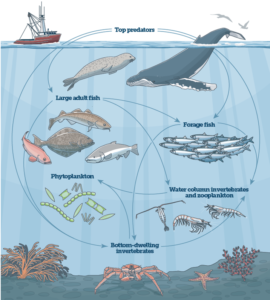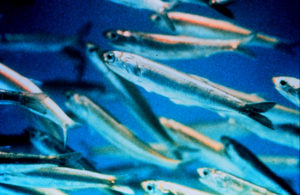Fate of Small Species Has Huge Implications for Our Ocean
November 17, 2016
The Pacific Fishery Management Council should use science to set catch limits on anchovy.
By: Dr. Sylvia Earle
When most of us think of the ocean, we think big: It covers 71 percent of our planet, dictates our weather, and is home to the tallest mountain and deepest canyon on the planet, as well as the largest animal, the blue whale.
And yet the ocean relies on its smallest inhabitants, from the phytoplankton and zooplankton that underpin the food web to forage fish, species like sardines, herring, and anchovy that are often referred to as baitfish.
In recent years, numbers of some forage fish species have declined dramatically, causing a food shortage for a vast array of marine animals. The Pacific marine ecosystem, including right here in the San Francisco Bay, is already suffering the consequences, with well-publicized accounts of starving sea lion pups and brown pelican breeding failures among the most visible evidence.

The Pacific Fishery Management Council, which oversees 300,000 square miles of ocean waters off the California, Oregon, and Washington coasts has passed catch limits to protect some forage fish but has unfortunately been remiss on protecting one of the most critical—anchovy. In fact, the catch limits for anchovy are based on data from 1995, when the population was robust. The council, which meets again in mid-November, must seize this opportunity to prevent further impacts to California’s vibrant marine ecosystem and coastal communities.
Scientists say that anchovies are the single most important prey species for seabirds on the U.S. West Coast and rank first or second for many other major predators, including humpback whales, chinook salmon, dolphins, and sea lions.
A study published last November in the journal Fisheries Research indicated that the California anchovy population has dropped from a total estimated biomass of 1 million tons a decade ago to potentially as low as 20,000 tons in recent years. That’s less than the current annual catch limit of 25,000 metric tons for the waters off California. Think about that: If the research bears out, the current catch limit exceeds the entire subpopulation of northern anchovies along the California coast.
The predicament facing anchovy is not due solely to fishing: their numbers fluctuate with changes in ocean temperatures and typically surge during predominantly cold-water cycles. The unusually warm water in the Pacific Ocean presents real uncertainty about anchovy numbers into the future.
But fishing is a factor too. Fishery managers hadn’t paid much attention to anchovies until the sardine fishery collapsed last year and fishing pressure shifted toward anchovies. Unfortunately, it’s now becoming clear that the anchovy population isn’t any stronger than the sardine population.
 But there are clear signs fishery managers and regulators are heeding the call to protect forage fish. In May, the National Oceanic and Atmospheric Administration’s Fisheries Service (NOAA Fisheries) finalized a rule prohibiting commercial fishing from starting on seven other groups of prey species until fishery managers assess how that fishing would affect the broader ecosystem. That move enacted a policy adopted unanimously in 2015 by the Pacific Fishery Management Council for federal waters. And just last week, the California Department of Fish and Wildlife held a public hearing on its intent to implement these same protections in state waters.
But there are clear signs fishery managers and regulators are heeding the call to protect forage fish. In May, the National Oceanic and Atmospheric Administration’s Fisheries Service (NOAA Fisheries) finalized a rule prohibiting commercial fishing from starting on seven other groups of prey species until fishery managers assess how that fishing would affect the broader ecosystem. That move enacted a policy adopted unanimously in 2015 by the Pacific Fishery Management Council for federal waters. And just last week, the California Department of Fish and Wildlife held a public hearing on its intent to implement these same protections in state waters.
The council now must set reasonable catch limits on existing fisheries for northern anchovy in order to reflect best available science, ensure adequate forage for dependent predators, and prevent overfishing.
A healthy ocean depends on an abundant and diverse array of small organisms, including forage fish. If fishery managers fail to recognize and act upon those facts, we may soon think of our ocean not as a vast, blue, vibrant wonder but as one big regret.
Dr. Sylvia Earle is a National Geographic Society Explorer-in-Residence, oceanographer, explorer, author, and founder of the Sylvia Earle Alliance / Mission Blue. Her current work includes finding more Hope Spots.
Join Sylvia Earle and Mission Blue for our first ever Twitter chat called #fishforthought where we will ask an important question, should we stop eating fish? Tuesday November 22nd at 9:30am Pacific. Your opinion matters. Make it heard!








Yet another eye-opening article. Awareness is the key, and I will assist in the wake up call to action.
Thank you for your passion.
@nuffsaid_h2o